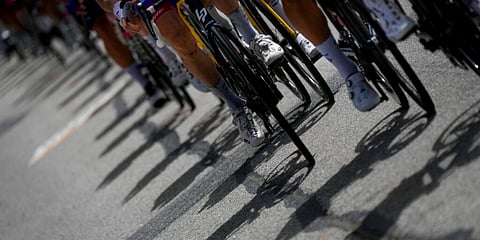

PARIS: Bike technology has become so important to elite road racing teams that the sport has, one rider said, "become like Formula One".
When the first significant stage race of the season, Paris-Nice, starts on Sunday, riders will be watching their rivals and complaining that others have better bikes.
"Everyone is talking about the bike now," says French rider Axel Laurance.
"It's so fast that the smallest difference becomes very important. In the peloton, you see the guy who goes at the same speed as you, even though he's not pressing the pedals as hard."
At Laurance's new team, the Belgian outfit Alpecin, his bike "moves on its own" compared to the one he had last season at B&B Hotels.
The machines may look the same, but they are not.
"On the surface, a bike is still a bike. It has wheels, handlebars and that's it. In reality, it's much more complicated. There are huge differences," said French rider Benoit Cosnefroy of AG2R-Citroen.
It is a trend that, riders and team managers agree, has accelerated in recent years.
"Before, they all had almost the same bikes. Today, there are big differences," said French rider Anthony Perez of Cofidis.
"The frame, the wheels, the tyres... add everything up and you go from a tradesman’s two-wheeler to a rocket. Cycling has become like Formula 1."
Thomas Damuseau, a former professional racer who is head of equipment at the AG2R agrees.
"We're getting close to it," he said, adding that AG2R's equipment manufacturer BMC "works with Red Bull and the same engineers who develop F1 cars".
When he broke the world one-hour record in October, Italian Filippo Ganna rode a custom-built time-trial bike with a 3D-printed carbon-fibre frame with aerodynamic lumps copied from bony tubercles on humpback whale fins.
Last year, Dane Jonas Vingegaard won the Tour de France in an average speed of 42.102 kilometres an hour, smashing the record of 41.654kph set by Lance Armstrong in 2005, the last year he finished first.
The American was later stripped of his seven Tour titles for taking performance enhancing drugs.
"The bikes have become so efficient that it explains the increase in race averages," said Damuseau.
The sport's governing body, the UCI, has rules that racers must ride production models available to the public, a market that manufacturers hope to capture with high-profile race victories.
Two-speed peloton
The technological progress led to dark mutterings in the peloton. After a rider was caught with a tiny concealed motor inside her bike at the 2016 cyclo-cross world championships, the UCI stepped up the fight against 'mechanical doping', toughening punishments and wheeling out x-ray machines and thermal imaging cameras to scan bikes.
The quality of the equipment is in danger of creating, as doping did, a two-speed peloton where the rich teams have an edge.
"Obviously, the rider is still the horse. But between fully-developed bikes from manufacturers with means and others who are more limited, it's night and day.
"The riders understand this, they talk about it among themselves in the peloton. And when they have to choose their future team, they look at the bike before the contract," said Damuseau.
The riders agree that the bike now comes first.
"It's an investment. If you have results with a good bike, your salary will follow," said Czech rider Zdenek Stybar.
"I will be at the end of my contract this season and for the years to come the bike is my number one priority," said Cosnefroy.
His boss at AG2R, Julien Jurdie said bikes attract big-name riders who are, in turn, the key in the "war to get the contract of the right manufacturers".
"When it comes to recruitment, in all the discussions we have, the first question that comes up is the bike," he said.
"Those who have the stars also have the best bikes."
Sometimes manufacturers go straight to the star riders, such as Slovakian Peter Sagan, who brought his bike supplier with him when he joined TotalEnergies in 2022.
"Without his bike, he wouldn't sign. He has only ridden Formula 1s. He doesn't know what a go-cart is," said Perez.